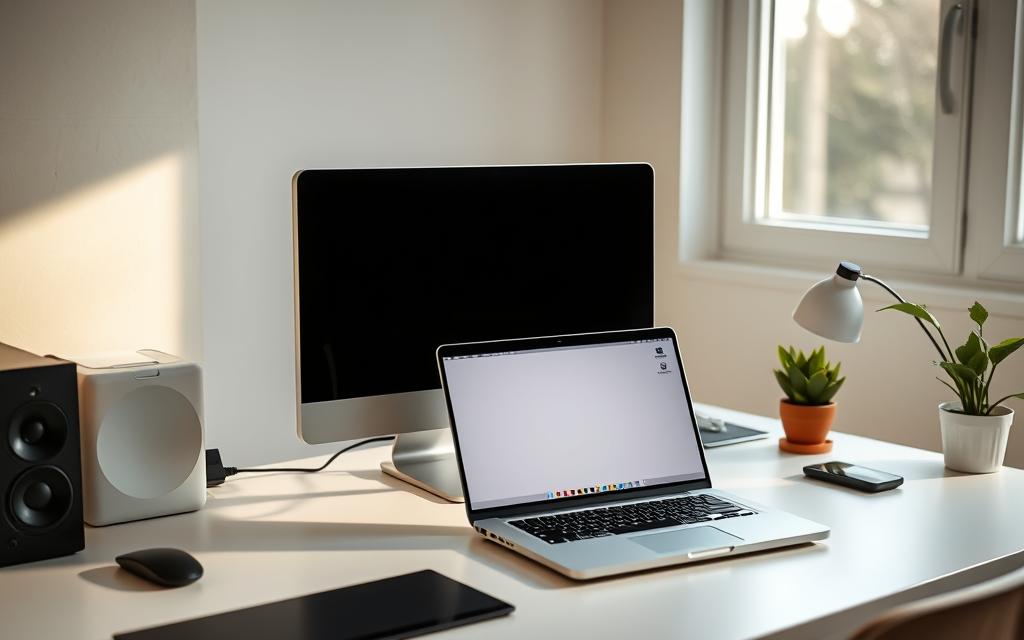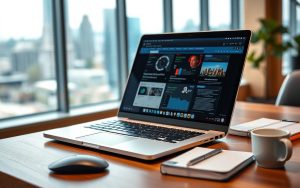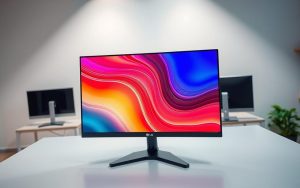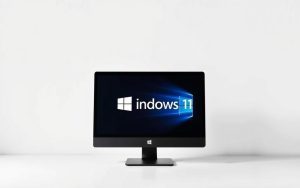Table of Contents
Expanding your workspace doesn’t require buying an extra monitor. With the right tools, your spare laptop can serve as a secondary display, boosting productivity without extra costs.
Modern Windows 10 and 11 systems support Microsoft Miracast, allowing seamless wireless projection. This feature turns any compatible device into an extended screen, perfect for multitasking or creative workflows.
Setting it up is straightforward. Whether for work, gaming, or design, repurposing your device maximizes efficiency. Follow this guide to unlock dual-screen functionality effortlessly.
Why Use Your Laptop as a Second Monitor?
Boost efficiency instantly by transforming unused devices into extra screen space. A second monitor enhances workflow, letting you manage emails, designs, or data side by side. Studies show multi-display setups increase productivity by 30-40%.
Repurposing your laptop saves money. Instead of buying new hardware, maximize existing real estate. This cost-effective solution is ideal for freelancers, students, or remote teams.
- Flexibility: Dedicate one screen to video calls and another to tasks.
- Wireless vs. wired: Choose between quick wireless setup or stable wired connections.
- Temporary or permanent: Adapt your workspace for short-term projects or daily use.
For deeper insights, explore the advantages of multi-monitor setups in professional environments.
Prerequisites for Using a Laptop as a Monitor
A smooth dual-screen experience starts with proper system preparation. Ensure both devices meet technical criteria to avoid connectivity issues. Below are the essential checks for seamless integration.
Hardware and Software Requirements
Your primary PC and secondary device must run Windows 10 or 11. Older versions lack native wireless display support. Verify these components:
- Wi-Fi adapters: Both devices need functional wireless hardware for Miracast.
- Display drivers: Update graphics drivers to the latest version for optimal resolution.
- System updates: Install pending Windows updates to patch compatibility gaps.
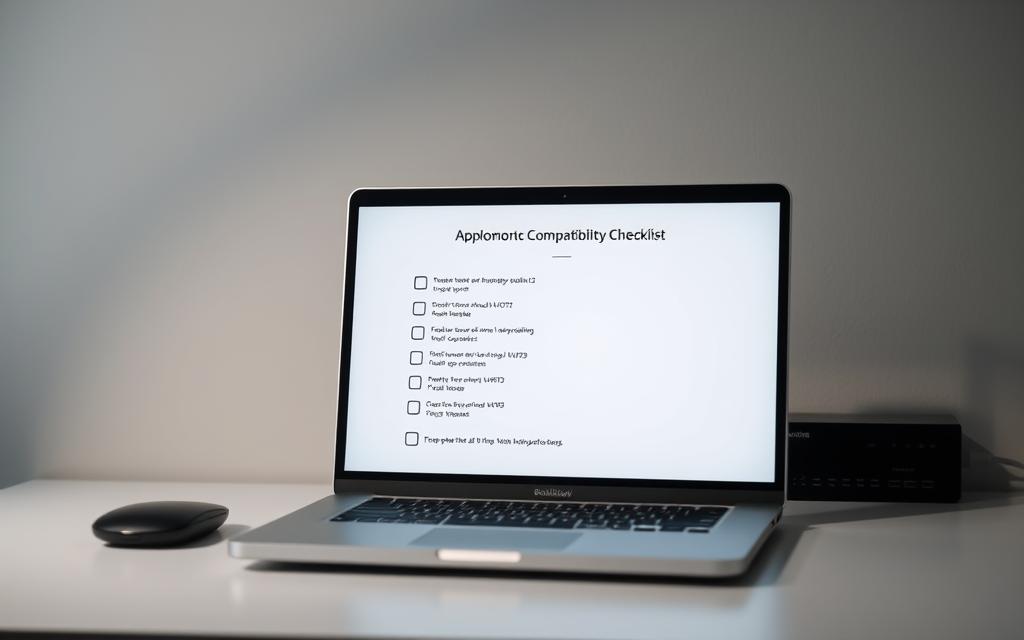
Network and Compatibility Checks
Stable connectivity hinges on proper network configuration. For wireless projection:
- Connect both devices to the same Wi-Fi network or ensure they support peer-to-peer linking.
- Check display resolution settings. Mismatched resolutions may cause scaling issues.
- Enable “Project to this PC” in Windows settings under System > Display.
For wired alternatives, HDMI or USB-C ports must support video input. Consult manufacturer specs for hardware limitations.
How to Use a Laptop as a Monitor for PC
Wireless projection transforms your device into a versatile workspace extension. Follow these steps to configure your secondary display effortlessly.
Enable Projection on Your Secondary Device
Open the Start Menu and search for Projection settings. Select Always available on secure networks for flexible connections. Adjust pairing preferences to First Time Only or require a PIN for added security.
Connect via Wireless Display
On your primary PC, press Win + P and choose Connect to a wireless display. Select your laptop from the detected devices. Enter the PIN pairing code shown on the secondary screen to finalize the link.
Customize Display Modes
After connecting, pick between two modes:
| Mode | Best For | Setup |
|---|---|---|
| Extend | Multitasking | Drag windows across screens |
| Duplicate | Presentations | Mirror content identically |
For advanced configurations like audio routing or input sharing, visit this detailed guide.
Alternative Methods to Connect Your Laptop as a Monitor
When wireless connectivity isn’t an option, wired and third-party solutions offer reliable alternatives. These methods cater to users needing low-latency performance or facing compatibility issues with Miracast.
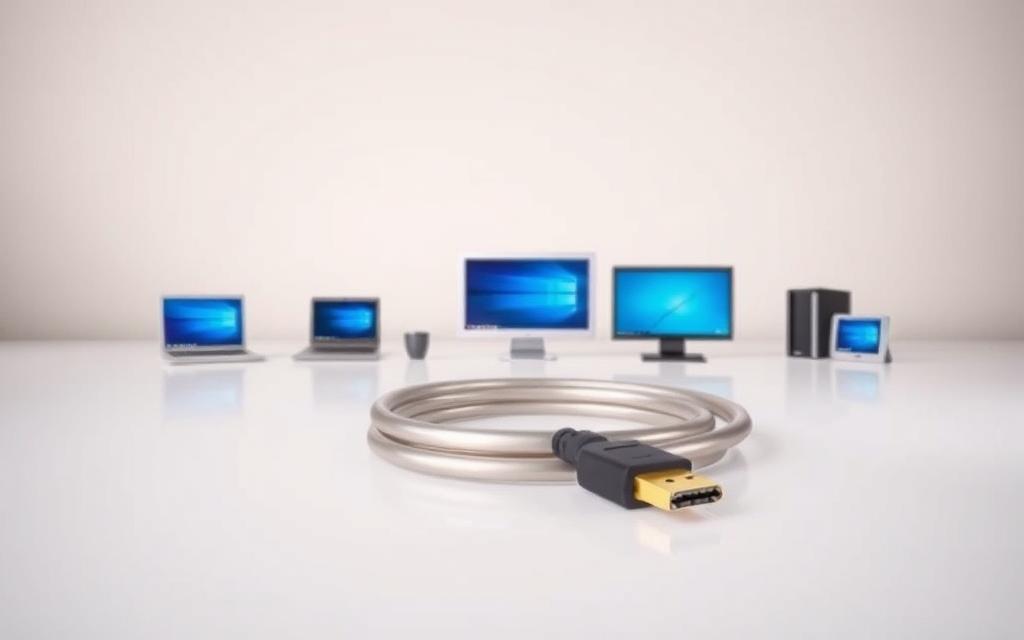
Using HDMI or Capture Devices
Direct connections via HDMI or USB-C bypass Wi-Fi dependency. However, most laptops lack video-input ports, requiring a capture card for signal conversion.
- HDMI limitations: Only works if your laptop supports video-in (rare).
- Capture devices: Convert output from your PC into a readable signal for the laptop. Brands like Elgato offer plug-and-play models.
- Latency: Wired connections reduce lag to under 10ms, ideal for gaming or video editing.
“Capture cards are a game-changer for streamers needing a secondary display without wireless delays.”
Third-Party Software Solutions
Tools like Splashtop or SpaceDesk emulate a second screen over networks. They’re versatile but require stable bandwidth.
| Solution | Best For | Latency |
|---|---|---|
| Splashtop | Remote work | 20–50ms |
| SpaceDesk | Creative workflows | 15–40ms |
For budget-conscious users, free tools like Spacedesk provide basic functionality at zero cost. Paid options offer advanced features like multi-device support.
Troubleshooting Common Connection Issues
Technical hiccups may occur when extending your desktop across devices. These solutions address frequent wireless display challenges:
- Firewall conflicts blocking projection connections
- Outdated drivers causing detection failures
- Network bandwidth affecting performance

When Your Device Doesn’t Appear as a Display
Reset projection settings if the secondary screen remains undetected. Navigate to Windows Settings > System > Display and toggle “Project to this PC” off/on.
For persistent issues:
- Update wireless adapters via Device Manager
- Allow “Wireless Display” through Windows Defender Firewall
- Restart both devices to refresh connection protocols
Resolving Audio and Input Lag
Latency above 50ms disrupts workflows. Try these adjustments:
| Solution | Implementation | Expected Improvement |
|---|---|---|
| Network priority | Set projection traffic as high priority in router settings | 20-30% reduced lag |
| Power plan | Switch to High Performance mode in Power Options | Stable frame rates |
| Driver rollback | Revert to stable graphics driver versions | Fewer audio sync issues |
“Most projection problems stem from outdated network stacks. Always check for cumulative Windows updates first.”
Conclusion
Repurposing your spare device as a secondary display unlocks new productivity levels. A dual-screen setup streamlines workflows, whether for multitasking or creative projects.
For comfort, position screens at eye level using stands. This reduces neck strain during long sessions. Experiment with wireless or wired methods to find your ideal solution.
Small adjustments boost performance. Align resolutions, update drivers, and prioritize ergonomics. Start small—even basic configurations yield significant efficiency gains.
FAQ
Can any laptop be used as a second monitor?
Most modern laptops running Windows 10 or 11 support wireless display projection. However, older models or those without compatible hardware may require HDMI connections or third-party software.
Do I need special cables to connect my laptop as a monitor?
Wireless connections require no cables, but HDMI or USB-C may be needed for direct video input. Some setups may also need a capture device for signal conversion.
Why isn’t my laptop appearing as a wireless display?
Ensure both devices are on the same network, Miracast is enabled in Windows settings, and your laptop supports wireless projection. Updating graphics drivers often resolves detection issues.
Can I use my laptop’s keyboard and mouse with my main PC?
Yes, through software like Microsoft’s Mouse Without Borders or third-party tools like Synergy. This allows seamless control across both screens without additional hardware.
Does using a laptop as a monitor affect performance?
Wireless methods may introduce slight input lag, especially for high-resolution content. For optimal performance, wired connections like HDMI or dedicated capture devices are recommended.
Are there free software solutions for this setup?
Yes, tools like Spacedesk or Windows’ built-in Project feature offer free solutions. Paid alternatives like Duet Display provide enhanced features for professional use.


